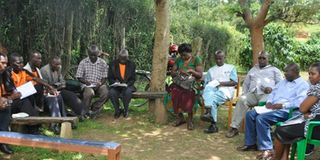Government to insure farmers against risks

Ministry of Finance officials meeting farmers in Ankole as part of a consultative meeting about the Uganda Agricultural Insurance Scheme. PHOTO BY EDGAR R. BATTE
What you need to know:
At the launch event last week, which was attended by President Yoweri Museveni, Finance minister, Matia Kasaija observed that despite the great role agriculture plays, it faces a number of challenges and risks such as excessive rains, fire, flooding, drought, epidemics, crop pests and diseases, limited access to finance, among others
At the launch of Uganda Agricultural Insurance Scheme (UAIS), the Finance minister, Matia Kasaija, commended farmers for the passion they put in their activities. He said this was in tandem with Vision 2040 which aims at a middle income status.
He explained that in order to achieve the goal, agriculture, which employs more than 65 per cent of the households and contributes 78 per cent of the country’s export earnings, is among the key sectors to play a major role towards the country’s development agenda.
Sound scheme
Agriculture is also the largest provider of raw materials for the industrial sector and contributes more than 27 per cent of the GDP. Therefore, to effectively help farmers further, an agricultural insurance scheme has been introduced.
The UAIS describes the conceptual and implementation requirements to develop and maintain a sound agriculture insurance scheme.
It also takes into account strategic decisions to be taken by the government and the private sector, which includes insurance, banking, farmers’ and input dealers associations, among other stakeholders.
Representatives of the ministry of Finance has been on a nationwide consultative/sensitisation meetings with farmers and farmers’ groups.
The inquiry is also on if these players think government coming out to insure their farms and produce is a good idea; most of them welcomed the idea.
This was in collaboration with Usaid-funded Feed the Future programmes in Uganda.
At the launch event last week, which was attended by President Yoweri Museveni, Kasaija observed that despite the great role agriculture plays, it faces a number of challenges and risks such as excessive rains, fire, flooding, drought, epidemics, crop pests and diseases, limited access to finance, among others.
Insurance subsidy
These greatly affect farm production and productivity.
For example, in the last five years, there has drought in Ankole, flooding in Kasese and Teso as well as landslides in Bududa.
These resulted in food insecurity and reduced household income in the affected communities because farmers had no fall-back position.
It is against the background that the government will provide an insurance premium subsidy to farmers, who directly purchase agriculture insurance products.
It will also provide an insurance premium subsidy to farmers accessing agriculture financing through financial institutions.
Depends on agreement
The insurance scheme is thus a cover that protects agricultural producers, including farmers, ranchers and others against either loss of crops or livestock due to pests and diseases; natural disasters, such as hail, drought, and floods.
The risks covered depend on the farmer-insurer agreement. In some cases, the occurrence of these risks has been of catastrophic nature with adverse effects, including those of a long-term nature on the farmers and the economy.
The National Policy for Disaster Preparedness and Management highlights that in the past two decades, on average more than 200,000 Ugandans were affected every year by disasters.
A high incidence of disasters occurring in Uganda every year has a negative impact on both the economy and people. Disasters negate the gains in poverty reduction and development.
Below is a breakdown of the natural disasters faced by Ugandans.
According to the Final Paper on Uganda Agriculture Insurance Scheme, the Uganda Risk Assessment Study (RAS) carried out in July 2015 under the Platform for Agricultural Risk Management (PARM), a multi-donor partnership, the overall economic impact of agricultural risk is estimated to amount to $606m-$804m.
“Based on an agricultural GDP of $5.71b, losses therefore amount to between 10.61 per cent and 14.08 per cent of total annual production that is between 2.3 per cent and 3.1 per cent of the GDP of Uganda,” the paper says, in part.
Increase production
The scenario is not helped by the fact that the biggest portion is mainly smallholder farmers who do not have adequate mechanisms of mitigating such risk.
This trend is aggravated by the reluctance by the various financial institutions to invest in the sector.
In support of the above, different Insurance companies in Uganda came up to introduce agriculture insurance in 2013 as a risk mitigation strategy for farmers to adopt products and services designed to increase their production and productivity.
The insurance sector has offered agricultural insurance but the uptake has been insignificant due to the cost of insurance being high coupled with high investment requirements for development of appropriate agriculture insurance products.
Limited outreach
A case in point is the Kungula Consortium whose expenditure on developing the drought product was more than Shs1b more than the premium collected. It commenced in 2013 with eight insurance firms participating.
The finance minister said that there is limited outreach and uptake of insurance in the country, especially in the rural areas.
“I would like to call upon all farmers to organise themselves in farmer groups, cooperatives and NGOs in order to benefit from the [UAIS].”
Kasaija pointed out that a financially healthy rural economy requires a financially healthy farm production sector.




